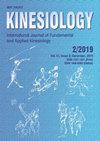在10公里业余赛跑中赛跑速度预测的现场和实验室测试的一致性和可重复性
IF 0.9
4区 医学
Q4 REHABILITATION
引用次数: 1
摘要
了解跑步速度,特别是通过易于应用的测试和低成本的方法,对于比赛策略的定义和整个准备阶段最合适的训练是重要的。目的是比较临界速度(CV),无氧阈值(AT)和模拟计时赛在赛道上的一致性和可重复性,以确定业余跑步者在10公里比赛中的跑步速度。对34名男女跑步者进行了横断面研究,年龄为42.4±11.0岁。我们测量了他们的CV,评估了他们的身体成分和AT。参加者还在10公里跑道上进行了模拟计时赛和10公里正式比赛。由CV、AT和赛道模拟计时赛确定的运行速度的比较δ和估计的标准误差分别为0.55 ~ -0.79 km/h和0.14 ~ 0.59 km/h。并将CV和AT与10 km跑速进行比较。CV、AT和赛道模拟计时赛的速度与10公里比赛的实时性吻合较好,重现性较好。本文章由计算机程序翻译,如有差异,请以英文原文为准。
Agreement and reproducibility of field and laboratory tests in the prediction of running speed in a 10-km race in amateur runners
Knowing running speed, particularly by means of easy-to-apply tests and
low cost, is important for the definition of the race strategy and the most
appropriate training throughout the preparation period. The aim was to compare
the agreement and reproducibility of critical velocity (CV), anaerobic threshold
(AT), and the simulated time trial on the track for the determination of the
running speed in a 10-km race in amateur runners. A cross-sectional study was
conducted with 34 runners of both genders aged 42.4±11.0 years. We measured
their CV, assessed their body composition and AT. Participants performed also a
simulated time trial on a 10-km running track and an official 10-km race. The
delta of the comparisons and the standard error of estimate between the running
velocities determined by the CV, AT, and the simulated time trial on the track
ranged from 0.55 to -0.79 km/h and 0.14 to 0.59 km/h, respectively.
Furthermore, CV and AT were compared to the 10-km running speed. Good agreement
and reproducibility were observed between the velocities determined by the CV,
AT, and the simulated time trial on the track with the real-time of a 10-km
official race.
求助全文
通过发布文献求助,成功后即可免费获取论文全文。
去求助
来源期刊

Kinesiology
REHABILITATION-SPORT SCIENCES
CiteScore
1.90
自引率
8.30%
发文量
16
审稿时长
>12 weeks
期刊介绍:
Kinesiology – International Journal of Fundamental and Applied Kinesiology (print ISSN 1331- 1441, online ISSN 1848-638X) publishes twice a year scientific papers and other written material from kinesiology (a scientific discipline which investigates art and science of human movement; in the meaning and scope close to the idiom “sport sciences”) and other adjacent human sciences focused on sport and exercise, primarily from anthropology (biological and cultural alike), medicine, sociology, psychology, natural sciences and mathematics applied to sport in its broadest sense, history, and others. Contributions of high scientific interest, including also results of theoretical analyses and their practical application in physical education, sport, physical recreation and kinesitherapy, are accepted for publication. The following sections define the scope of the journal: Sport and sports activities, Physical education, Recreation/leisure, Kinesiological anthropology, Training methods, Biology of sport and exercise, Sports medicine and physiology of sport, Biomechanics, History of sport and Book reviews with news.
 求助内容:
求助内容: 应助结果提醒方式:
应助结果提醒方式:


